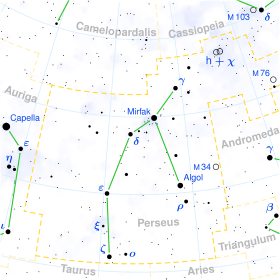Iota Persei
 | |
| Observation data Epoch J2000 Equinox J2000 | |
|---|---|
| Constellation | Perseus |
| Right ascension | 03h 09m 04.02s[1] |
| Declination | +49° 36′ 47.8″[1] |
| Apparent magnitude (V) | 4.062[2] |
| Characteristics | |
| Spectral type | F9.5 V[3] |
| U−B color index | +0.119[2] |
| B−V color index | +0.595[2] |
| Astrometry | |
| Radial velocity (Rv) | +50.0 km/s |
| Proper motion (μ) | RA: +1262.41[1] mas/yr Dec.: –91.50[1] mas/yr |
| Parallax (π) | 94.87 ± 0.23[1] mas |
| Distance | 34.38 ± 0.08 ly (10.54 ± 0.03 pc) |
| Absolute magnitude (MV) | 3.94[4] |
| Details | |
| Mass | 1.35±0.08[5] M☉ |
| Radius | 1.412±0.009[6] R☉ |
| Luminosity | 2.181±0.032[6] L☉ |
| Surface gravity (log g) | 4.31[5] cgs |
| Temperature | 5,963±5.1[7] K |
| Metallicity [Fe/H] | +0.09[8] dex |
| Rotational velocity (v sin i) | 4.1[5] km/s |
| Age | 3.2–4.1[5][8] Gyr |
| Other designations | |
| Database references | |
| SIMBAD | data |

Iota Persei (Iota Per, ι Persei, ι Per) is a main sequence dwarf star in the constellation Perseus. It is somewhat larger and greater in mass than the Sun, and is located about 34 light years distant. Iota Persei has a relatively high proper motion across the sky, and moves at a net velocity of 92 km/s, relative to the Sun.
No sub-stellar companions to this star have yet been found. There is a 12th-magnitude line-of-sight companion star that is not believed to be gravitationally associated with Iota Persei.
Naming
In Chinese, 大陵 (Dà Líng), meaning Mausoleum, refers to an asterism consisting of ι Persei, 9 Persei, τ Persei, κ Persei, β Persei, ρ Persei, 16 Persei and 12 Persei. Consequently, ι Persei itself is known as 大陵三 (Dà Líng sān, English: the Third Star of Mausoleum.).[9]
See also
References
- 1 2 3 4 5 van Leeuwen, F. (2007). "Validation of the new Hipparcos reduction". Astronomy and Astrophysics. 474 (2): 653–664. arXiv:0708.1752. Bibcode:2007A&A...474..653V. doi:10.1051/0004-6361:20078357. Vizier catalog entry
- 1 2 3 Jennens, P. A.; Helfer, H. L. (September 1975), "A new photometric metal abundance and luminosity calibration for field G and K giants", Monthly Notices of the Royal Astronomical Society, 172: 667–679, Bibcode:1975MNRAS.172..667J, doi:10.1093/mnras/172.3.667.
- ↑ Gray, R. O.; et al. (July 2006), "Contributions to the Nearby Stars (NStars) Project: spectroscopy of stars earlier than M0 within 40 pc-The Southern Sample", The Astronomical Journal, 132 (1): 161–170, arXiv:astro-ph/0603770, Bibcode:2006AJ....132..161G, doi:10.1086/504637.
- ↑ Holmberg, J.; et al. (July 2009), "The Geneva-Copenhagen survey of the solar neighbourhood. III. Improved distances, ages, and kinematics", Astronomy and Astrophysics, 501 (3): 941–947, arXiv:0811.3982, Bibcode:2009A&A...501..941H, doi:10.1051/0004-6361/200811191.
- 1 2 3 4 Valenti, Jeff A.; Fischer, Debra A. (July 2005). "Spectroscopic Properties of Cool Stars (SPOCS). I. 1040 F, G, and K Dwarfs from Keck, Lick, and AAT Planet Search Programs". The Astrophysical Journal Supplement Series. 159 (1): 141–166. Bibcode:2005ApJS..159..141V. doi:10.1086/430500. Note: see VizieR catalogie J/ApJS/159/141.
- 1 2 Boyajian, Tabetha S.; et al. (February 2012), "Stellar Diameters and Temperatures. I. Main-sequence A, F, and G Stars", The Astrophysical Journal, 746 (1): 101, arXiv:1112.3316, Bibcode:2012ApJ...746..101B, doi:10.1088/0004-637X/746/1/101 . See Table 10.
- ↑ Kovtyukh, V. V.; et al. (2003). "High precision effective temperatures for 181 F-K dwarfs from line-depth ratios". Astronomy and Astrophysics. 411 (3): 559–564. arXiv:astro-ph/0308429. Bibcode:2003A&A...411..559K. doi:10.1051/0004-6361:20031378.
- 1 2 Mamajek, Eric E.; Hillenbrand, Lynne A. (November 2008). "Improved Age Estimation for Solar-Type Dwarfs Using Activity-Rotation Diagnostics". The Astrophysical Journal. 687 (2): 1264–1293. arXiv:0807.1686. Bibcode:2008ApJ...687.1264M. doi:10.1086/591785.
- ↑ (in Chinese) AEEA (Activities of Exhibition and Education in Astronomy) 天文教育資訊網 2006 年 7 月 11 日
External links
- "Iota Persei". SolStation. Retrieved 2006-07-25.
- "Gl 124". ARICNS. Retrieved 2006-07-25.
- "Iota Per". Prof. Jim Kaler. Retrieved 2006-07-25.